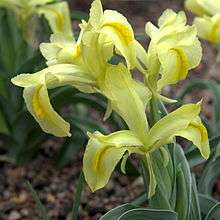Iris caucasica
| Iris caucasica | |
|---|---|
 | |
| Scientific classification | |
| Kingdom: | Plantae |
| (unranked): | Angiosperms |
| (unranked): | Monocots |
| Order: | Asparagales |
| Family: | Iridaceae |
| Subfamily: | Iridoideae |
| Tribe: | Irideae |
| Genus: | Iris |
| Subgenus: | Scorpiris |
| Species: | Iris caucasica |
| Binomial name | |
| Iris caucasica Hoff. | |
| Synonyms | |
| |
Iris caucasica (also known as Caucasean Iris)[2][3] is a species of plant in the genus Iris, it is also in the subgenus of Scorpiris. Pronounced as 'kaw-KAS-ee-kuh'.[4]
It was described in 'Commentat. Soc. Phys.' to Caesareae Universitatis Mosquensis of 1808 by Georg Hoffman.[5]
It was once confused with iris orchioides, but iris caucasica is a smaller plant, with sessile flowers. Also it has leaves that have white margins.[6]
Iris caucasica is an accepted name by the RHS.[2]
Habit
It has between 1–4 flowers per stem, normally pale yellow or green and with winged falls.[7] The falls also have a yellow ridge.[8] The flowers are 5–15 cm (2–6 in) across.[7] It flowers in later spring.[9] It eventually reaches a height of 15 cm (flower and stem).[9] he flowers are not fragrant.[6]
It has grey green leaves,[8] which are ciliate[9] and that start growing at flowering time.[7] They reach up to 10–12 cm long and l-2 cm wide.[9] The leaves have a faint white margin.[10]
It has a brown ovoid bulb with fleshy roots.[6] It is similar to Iris persica.[3]
Native
Iris caucasica grows on limestone mountain slopes (at 1200-3500m above sea level)[9] in Turkey[8] and Armenia and Azerbaijan,[11] in the Caucasus mountains.[8] Bieberstein notes seeing it near Tbilisi in the South Caucasus.[3] It has also been found in Israel and Iran.[10]
Hybrids
In 1892, Michael Foster introduced a hybrid version 'Iris Caucasica Kharput'.[4] Which does not have winged falls.[7] It still has 4–5 flowers per stem, which are greenish-yellow. But they are generally larger than parent plant.[6]
References
- ↑ "Iris caucasica Hoffm.". www.theplantlist.org. Retrieved 11 August 2014.
- 1 2 "Iris caucasica". www.rhs.org.uk. Retrieved 11 August 2014.
- 1 2 3 Robert Sweet, Edwin Dalton Smith (1904)The British Flower Garden: Containing Coloured Figures & Descriptions of the Most Ornamental & Curious Hardy Herbaceous Plants (1829), p. 255, at Google Books
- 1 2 "Iris caucasica 'Caucasica Kharput'". davesgarden.com. Retrieved 16 August 2014.
- ↑ "Iris caucasica Hoffm". apps.kew.org. Retrieved 15 August 2014.
- 1 2 3 4 Lynch, Richard (1904)The Book of the Iris, p. 176, at Google Books
- 1 2 3 4 Cassidy, G.E.; Linnegar, S. (1987). Growing Irises (Revised ed.). Bromley: Christopher Helm. p. 146. ISBN 0-88192-089-4.
- 1 2 3 4 "JunoIrises". www.pacificbulbsociety.org. Retrieved 15 August 2014.
- 1 2 3 4 5 "Iris caucasica". encyclopaedia.alpinegardensociety.net. 2011. Retrieved 16 August 2014.
- 1 2 "Iris - Caucasus Yellow,Caucasus Yellow Iris". www.searchlifeforms.com. Retrieved 15 August 2014.
- ↑ "Taxon: Iris caucasica Hoffm.". ars-grin.gov. Retrieved 15 August 2014.
Sources
- Czerepanov, S. K. 1995. Vascular plants of Russia and adjacent states (the former USSR). (L USSR) [noted as 'Juno caucasica' (Hoffm.) Klatt].
- Davis, P. H., ed. 1965–1988. Flora of Turkey and the east Aegean islands. (F Turk)
- Komarov, V. L. et al., eds. 1934–1964. Flora SSSR. (F USSR)
- Mathew, B. 1981. The Iris. (Iris) 146.
- Rechinger, K. H., ed. 1963–. Flora iranica. (F Iran)
- Townsend, C. C. & E. Guest. 1966–. Flora of Iraq. (F Iraq)
External links
![]() Media related to Iris caucasica at Wikimedia Commons
Media related to Iris caucasica at Wikimedia Commons
![]() Data related to Iris caucasica at Wikispecies
Data related to Iris caucasica at Wikispecies